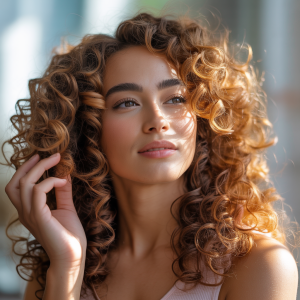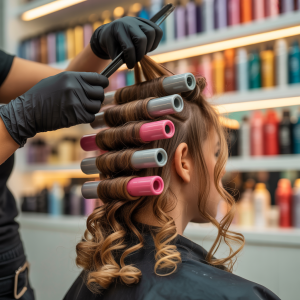If you’re contemplating a hair perm, knowing what’s involved can save you from surprises and help you get the look you want. A perm isn’t just about curls; it’s a chemical process that changes your hair’s texture, so preparation matters. Before you book, it’s essential to understand how different perm types work and what your hair needs to handle the treatment. There’s more to reflect on than just the result.
Understanding What a Hair Perm Is
A hair perm is a chemical treatment that changes the texture of your hair by creating curls or waves.
When you get a perm, a chemical solution breaks down your hair’s natural structure, allowing it to be reshaped. The perming process involves wrapping your hair around rods or rollers before applying this solution.
Once the solution sets, it changes the bonds in your hair to hold the curls or waves in place. Perming is a popular way to achieve curly hair without heat styling every day.
You’ll want to understand that the chemical solution used can affect your hair’s health, so it’s important to follow the aftercare instructions carefully.
The Science Behind Perming Hair
Because perming involves changing your hair’s structure, understanding the science behind it can help you appreciate how the process works and what to expect.
The solution used contains a chemical that breaks down your hair’s natural bonds, allowing it to be reshaped. During the process, your hair is wrapped tightly around perm rods to create the desired curl pattern.
Once the chemical has softened the hair, a neutralizer is applied to rebuild the bonds in their new curled form, locking in the shape. This two-step chemical reaction is what transforms your straight or wavy hair into lasting curls or waves.
Knowing this helps you understand why proper timing and product choice are essential for healthy, effective results.
Different Types of Hair Perms Available
Understanding how perming changes your hair’s structure sets the stage for choosing the right type of perm for your look.
There are several types of perms, each offering different curls and waves. A traditional perm uses a chemical treatment to create firm, lasting curls. If you want looser waves, a body wave perm softens the texture without tight coils.
Spiral perms give you defined, bouncy curls that add volume and flair. Your stylist might also suggest digital or acid perms, which tend to be gentler and better for fine or damaged hair.
For expert guidance and personalized recommendations, trust the professionals at Fresh Salon & Spa by Hollys. Each type of perm involves a specific chemical process tailored to your desired style and hair condition—something the team at Fresh Salon & Spa by Hollys specializes in delivering with care.
Knowing these options helps you communicate clearly with your stylist before booking a consultation at Fresh Salon & Spa by Hollys.

Choosing the Right Perm for Your Hair Type
When choosing the right perm for your hair type, you’ll want to take into account your hair’s texture, porosity, and overall health.
Different hair types react differently to perm solutions, so understanding yours helps prevent damage. If you have fine or fragile hair, opt for a milder perm to avoid damaging your hair. Coarser hair can usually handle stronger solutions that create tighter curls.
Among the common types, alkaline perms work well for resistant hair, while acid perms suit fragile strands better. If you want loose, natural-looking curls, a body wave perm might be ideal.
Always discuss your hair type with your stylist to guarantee your permed hair turns out just right without compromising its health.
How to Prepare Your Hair Before a Perm
Preparing your hair properly before a perm can make all the difference in achieving long-lasting, beautiful curls. Start by avoiding washing your hair the day of your appointment; shampoo your hair 24 to 48 hours before. This allows your scalp’s natural oils to protect your hair during the perm process.
When preparing hair, make certain it’s clean but not freshly shampooed. Your hair should be dry or only slightly damp when you arrive, as your hairdresser will assess its condition before starting.
Avoid using heavy styling products or conditioners that can interfere with the perm solution. Communicate openly with your hairdresser about your hair’s history and any damage to guarantee your perm hair comes out healthy and vibrant.
What Happens During the Perming Process
Although the perming process might seem complex, your stylist will guide you step-by-step to transform your hair.
First, they’ll wrap sections of your hair around rods, choosing sizes to create the type of curl or wave you want. These rods shape your hair as the perm solution is applied to break down the hair’s structure.
Once the solution has processed, your stylist rinses it out while keeping the rods in place to lock in the new shape. Then, they apply a neutralizer to set the curls or waves permanently.
After removing the rods and a final rinse, your permed hair will have lasting texture and volume.
Throughout, your stylist guarantees the perm is gentle and tailored to your hair’s needs.
How Long Does a Perm Take?
Wondering how much time you’ll need to set aside for a perm? Typically, the entire process takes about two to three hours.
The time varies depending on factors like the length of your hair, the size of the roller used, and the tightness of the curls you want. Longer hair naturally requires more time to wrap around rollers and process. If you opt for tighter curls, expect a longer setting time to guarantee the hairstyle holds well.
Once your hair is rolled and the solution applied, you’ll wait for it to set before rinsing and styling.
Keep in mind, a well-permed hairstyle takes patience, but the results are worth the wait. Planning helps you enjoy the transformation without feeling rushed.
The Role of Chemicals in Perming
Once your hair is wrapped and the waiting begins, chemicals take center stage in creating those lasting curls.
Perms work by breaking down the hair’s natural bonds with a chemical solution, allowing it to reshape around the rods. After the desired curl forms, a neutralizer locks in the style by rebuilding those bonds.
Some lotions applied during the process help reduce frizz and add moisture, ensuring your curls stay smooth and defined. These carefully balanced chemicals are essential to forming a permanent wave that lasts for months.
Understanding this process helps you appreciate how the right products and timing impact your perm’s success, giving you the beautiful, manageable curls you want without unnecessary damage.
Common Myths About Hair Perms
How much do you really know about hair perms? Many myths surround this styling technique.
For instance, some think perms include only tight, unnatural curls, but they actually create a variety of looks from loose waves to bouncy curls depending on the curler size used.
Another myth is that perms ruin your hair texture permanently. In reality, getting a perm temporarily changes your hair’s structure, and it returns to normal after a few months.
You might also believe perms are only for certain hair types, but they can work well on many textures with proper care.
Understanding these facts helps you make informed decisions and avoid unnecessary worries when considering a perm.
Potential Risks and Side Effects of Perms
Although perms can give you beautiful, lasting curls, they also come with potential risks and side effects you should consider before making a decision.
A perm uses chemicals that can sometimes cause dryness or irritation to your scalp. If you have sensitive skin, these chemicals might lead to redness or even mild burns.
Your hair may feel dry and brittle after the treatment, especially if it’s already damaged. Overprocessing can weaken your strands, making your new style less vibrant and more prone to breakage.
It’s important to weigh these risks against the look you want. Understanding how the chemicals interact with your hair and scalp helps you avoid unwanted dryness and irritation, ensuring you achieve a perm style that’s both beautiful and healthy.
How to Care for Your Hair After a Perm
Taking proper care of your hair after a perm helps prevent dryness and breakage caused by the chemicals used during the process.
To take care of your hair permed, use gentle, sulfate-free shampoos and conditioners that hydrate and strengthen your curls. Avoid washing your hair too often; spacing washes helps maintain the perm’s long-lasting effect.
When towel-drying, pat your hair gently instead of rubbing to avoid frizz and damage. For your day-to-day routine, apply leave-in conditioners or curl creams to keep your hair moisturized and manageable.
Limit heat hairstyling tools, since excessive heat can weaken your curls. By following these simple steps, you’ll preserve your perm’s bounce and health, ensuring your new hairstyle stays vibrant and beautiful longer.

Styling Tips for Permed Hair
Many styling options can help you showcase your permed hair’s natural texture and volume. To keep your curls looking bouncy, avoid heavy products that weigh them down. Instead, use lightweight mousse or curl enhancers to define each spiral and ringlet.
When drying, gently scrunch your hair rather than rubbing it, helping your curls stay intact. You can also refresh your curls by wrapping damp sections around your fingers or a small curling wand to recreate that perfect bounce.
Avoid brushing your permed hair when dry, as it can disrupt the shape of your ringlets. Instead, use a wide-tooth comb when wet to detangle.
With these tips, your permed hair will maintain its lively, wrapped-around charm and natural movement every day.
How Long Does a Perm Last?
Curious about how long your perm will last? Typically, a perm can hold its shape for about two to six months, depending on your hair type and care routine.
Cold perms and hot perms differ mainly in technique; hot perms use heat and often a plastic cap to help set curls, usually processed in about two hours. Cold perms rely on chemical solutions without heat and may feel gentler on hair.
Regardless of the method, proper aftercare extends the life of your curls. Avoid overwashing and use products designed for permed hair to keep your style fresh.
Can You Perm Colored or Chemically Treated Hair?
Maintaining your perm’s bounce can be a bit trickier if your hair has been colored or chemically treated.
When your hair’s natural texture has already changed, applying a perm requires extra care. Chemically treated hair is more fragile, so choosing a gentle perm formula designed for such hair is vital. Your stylist will likely recommend a milder solution to minimize damage and preserve your hair’s integrity.
It’s also important to nourish your hair before and after the perm to keep it healthy and prevent breakage.
While you can perm colored or chemically treated hair, you should be prepared for potentially different results compared to untreated hair. Consulting a professional will help guarantee your perm complements your hair’s condition and maintains its strength.
Cost Factors to Consider When Getting a Perm
Before you decide to get a perm, it’s important to understand the factors that affect its cost. Several cost factors come into play, including your hair length longer hair requires more product and time, increasing the price.
The type of rod used also matters; smaller rods create tighter curls but often take longer, potentially raising the cost. Additionally, perms with keratin treatments, which help protect and strengthen your hair, usually cost more than traditional perms.
Your stylist’s expertise and the salon’s location can also influence pricing. Knowing these details helps you budget better and set realistic expectations for your perm experience.
Keep these cost factors in mind, so you can make an informed decision that suits both your style and wallet.
Signs You Should Avoid Getting a Perm
Understanding the costs involved in getting a perm is important, but so is recognizing when it’s best to hold off.
There are key signs you should avoid getting a perm to protect your hair’s health. If you have severely damaged or brittle hair, a perm can worsen breakage.
People with straight hair might consider a straight perm to soften curls, but if your hair is coarser or already chemically treated, perming can lead to uneven results or damage.
Also, if you’re prone to scalp sensitivity or allergies, perm chemicals may irritate.
Before you book, you need to know about perms and evaluate your hair’s condition honestly.
If you notice excessive dryness, breakage, or scalp issues, it’s better to delay perming until your hair recovers.
How to Find a Skilled Stylist for Your Perm
How can you guarantee your perm turns out beautifully and lasts long? Start by finding a skilled stylist at Fresh Salon & Spa by Hollys who understands every step, from washing your hair properly to handling the clamp with care during the perm process.
Look for professionals at Fresh Salon & Spa by Hollys who explain the importance of keeping solutions at room temperature, as this guarantees even processing and prevents damage. A talented stylist focuses on adding definition to your curls while maintaining a voluminous, natural look.
Check reviews, ask for before-and-after photos, and confirm their experience with perm techniques tailored to your hair type. Don’t hesitate to ask how Fresh Salon & Spa by Hollys will customize the perm to suit your style goals.
A knowledgeable stylist will guide you through maintenance tips, guaranteeing your curls stay vibrant and healthy long after your appointment.
Alternatives to Traditional Hair Perms
While traditional perms have their charm, you might want to explore alternatives that offer different textures, less damage, or easier maintenance.
If you have shorter hair or shoulder-length or longer, several options can give you the curls or waves you want without the chemical intensity of a classic perm. For example, digital perms use heat to reshape hair, providing softer, more natural-looking waves that last longer.
Body waves are another gentle option, adding loose curls ideal for hair that’s shoulder-length or longer. If you prefer something temporary, consider styling with curling irons or texturizing sprays.
Understanding hair perm basics helps you decide which method suits your lifestyle and hair type. Exploring these alternatives to traditional hair perms can keep your hair healthy while achieving fresh, stylish looks.

How to Reverse or Remove a Perm Safely
If you’ve tried different perm styles but find that the results aren’t what you wanted, you might be wondering how to safely undo the process.
To reverse or remove a hair perm safely, it’s best to consult a professional stylist. They can use a relaxing treatment or a specialized neutralizer designed to break down the perm’s chemicals without causing excessive damage.
Avoid DIY methods, especially if you have thinner hair, since harsh treatments can cause breakage or dryness.
Another option your stylist might suggest is straightening treatments that can temporarily smooth out curls.
Frequently Asked Questions
Can I Swim or Exercise Soon After Getting a Perm?
You’ll want to give your new curls a little vacation from water and sweat for about 48 hours. Jumping in the pool or hitting the gym too soon could cramp your perm’s style and longevity.
What Should I Avoid Wearing on My Head Post-Perm?
You should avoid tight hats, headbands, or anything that puts pressure on your curls right after your perm. These can flatten or distort your new waves. Opt for loose, breathable headwear until your hair sets properly.
How Does Weather Affect My New Perm?
About 70% of people notice humidity affects their perm. You’ll find humid weather can make your curls frizzier, while dry, cold air might cause them to tighten or lose bounce. Adjust your care routine accordingly.
Will a Perm Make My Hair Dryer or Iron Less Effective?
A perm can make your hair dryer or iron slightly less effective because your hair becomes more textured and delicate. You’ll want to use lower heat settings and protect your curls to avoid damage and maintain style.
Can I Get a Perm While Pregnant or Breastfeeding?
Think of your body as a delicate garden; while some flowers bloom safely, others need gentle care. You should consult your doctor before getting a perm while pregnant or breastfeeding to keep both you and your baby safe.
Conclusion
Getting a perm can transform your look, offering lively curls where once there was straight hair. But remember, the chemical process demands care. Preparing your hair properly contrasts with the bold change you’ll see afterward. While the promise of lasting waves excites, it’s just as important to weigh potential damage and your hair’s health. By balancing enthusiasm with caution, you’ll guarantee your new curls are as beautiful as they are resilient.






